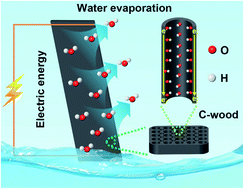Electricity generation from water evaporation through highly conductive carbonized wood with abundant hydroxyls†
Abstract
Electric energy harvesting from natural water evaporation has attracted great attention in the sustainable development of human society. However, ultra-low short-circuit current extremely hinders its widespread deployment. Herein, we report a high-performance wood-based hydroelectric generator (WHEG) based on highly conductive carbonized wood (C-wood) with abundant hydroxyls via a Lewis acid metal salt-catalyzed carbonization strategy. The high hydroxyl content greatly improves the zeta potential and the high electrical conductivity remarkably reduces the internal resistance, thus boosting the output of electrical energy from water evaporation. These advantages make the obtained WHEG (6.5 × 1.5 × 0.4 cm3) exhibit an open-circuit voltage of 96 mV and a remarkable short-circuit current of 10.5 μA under ambient conditions (45% RH, 25 °C), which is an order of magnitude higher than that of most previous studies. Furthermore, commercial electronics such as calculators and LEDs can be powered by the WHEG system in series or parallel connections.



 Please wait while we load your content...
Please wait while we load your content...